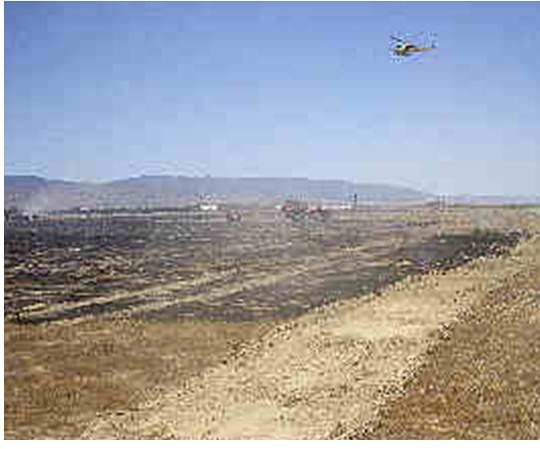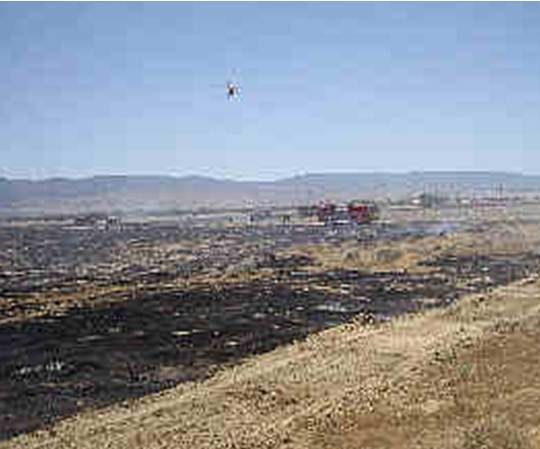The July 2 fire at the site of First Solar’s 230-megawatt Solar Ranch One, where construction is slated soon to begin on the world’s biggest photovoltaic (PV) solar power plant, drew furor from the project’s Antelope Valley neighbors. But the fire may have been a blessing in disguise.
The burning enmity between First Solar (FSLR: NASDAQ), the project owner-developer, and Fairmont, the immediately adjacent community, was fanned to flames by the 71-acre blaze that required four helicopters, 12 fire vehicles, and dozens of county firefighters to control.
First Solar reacted aggressively to charges by Fairmont Town Council officers that the fire represented “negligence” and “reckless disregard,” calling a spin control meeting in nearby Lancaster. Barely had First Solar construction director Tony Perrino begun his PowerPoint presentation with diplomatic non-apologies like “We recognize there were some errors made” when Fairmont residents exploded.
“You’ve got thousands of acres of gunpowder out there and you set a match to it,” Fairmont resident Pat Kennedy told Perrino, FSLR Development Director Jack Pigott and Solar Ranch One Construction Manager Gary Baumeister. “I’ll put up with snakes and coyotes but I will not put up with fire.”

The fire was ignited by engine heat from a truck stopped in dry desert grasses by people doing soil sampling for First Solar. Los Angeles County Fire Department Battalion Chief Clifford Meridth ruled it “accidental.”
Desert-savvy locals think otherwise. Fairmont Town Council Secretary David Jefferies called it “either ignorant or negligent.” The ignorance, locals say, was the result of the company failing to consult them, which led to negligence.
Development Director Pigott’s previous efforts to reach out to Fairmont leaders at June 27 and June 30 meetings only worsened the tension between the company and the community.
With three-quarters of a billion dollars in federal loan guarantees that will be lost if construction on Solar Ranch One is not significantly underway by September 30, First Solar has an enormous stake in coming to terms with Fairmont. Emails obtained by Greentech Media also suggest a settlement with Fairmont might calm major institutional investors who, though not direct stakeholders in Solar Ranch One, can reasonably be assumed to be among those who trade in the solar energy sector’s premier stock.
With 33 solar projects proposed for the western Antelope Valley and 13 already on the drawing boards, locals are determined to manage the development in their faces. “If you come off as an arrogant city dweller, you’re not going to make it in Fairmont,” Town Council President David Kerr said of Pigott’s efforts.
“He just doesn’t get it,” Town Council member Barbara Rogers added.
Among Fairmont’s concerns are the visual impact of fences at Solar Ranch One and the environmental impacts of leveling the ground, especially as it affects dust and wildlife.
_540_449_80.jpg)
According to fire witnesses, First Solar was potentially guilty of significant safety violations, including failing to have fire suppression equipment on site, failing to have water trucks on site and failing to have a fire safety officer present.
Even more grievously, it emerged that the geotechnical specialists hired to do the soil sampling were from Long Beach, though Pigott had promised Solar Ranch One jobs would go to locals. “We want jobs for this valley!” raged a local.
Mel Lane, President of the Greater Antelope Valley Economic Alliance, stood to defend First Solar but was shouted down. Declaring Lane a resident of Lancaster, a half-hour from the remote First Solar project, Richard Skaggs shouted, “Get them to build it in your backyard and then you can talk!”
As the confrontation worsened, Fairmont’s Kennedy looked directly at First Solar’s Pigott and forcefully suggested he join with other developers to fund an LA County Fire Department substation near the projects. “You know who will benefit most?” Kennedy asked Pigott. “You guys!”
Pigott looked suddenly interested.
John Sakers, First Solar’s Director of Environment and Safety, then introduced himself. It was immediately apparent he had the ability Pigott lacked to communicate with Fairmont residents. “There is no knowledge like local knowledge,” Sakers told them. “I hear the need for communication. I’d like to offer myself as a liaison.”
Baumeister added a promise to stop all further hiring until he learned more about the local workforce from Fairmont leaders.
Shutting down his uncompleted PowerPoint presentation, Perrino said he needed to add a last bullet point reading “talk to locals.”
A half-hour later at a previously scheduled Fairmont Town Council meeting, First Solar’s Sakers -- who had hustled over -- quieted an even more hostile and larger group of Fairmont residents by telling them he considered the fire to be the result of “an abysmal failure” by his company. “It was a completely unsatisfactory event,” he said. “Nothing about it was good. We will fix it.”
Fairmont’s Jefferies seemed interested. “You’ve got a deadline,” he told Sakers. “But your dollars are our dollars.”
At the end of the Town Council meeting, Fairmont voted to send a letter to the County Planning Commission asking for a review of the Solar Ranch One permit. But the meeting of minds in the two meetings suggested the possibility had finally emerged for a settlement similar to the one Fairmont reached this past spring with NRG Solar, heavy on considerations for the quality of life in Fairmont along with financial considerations for the community at large.




